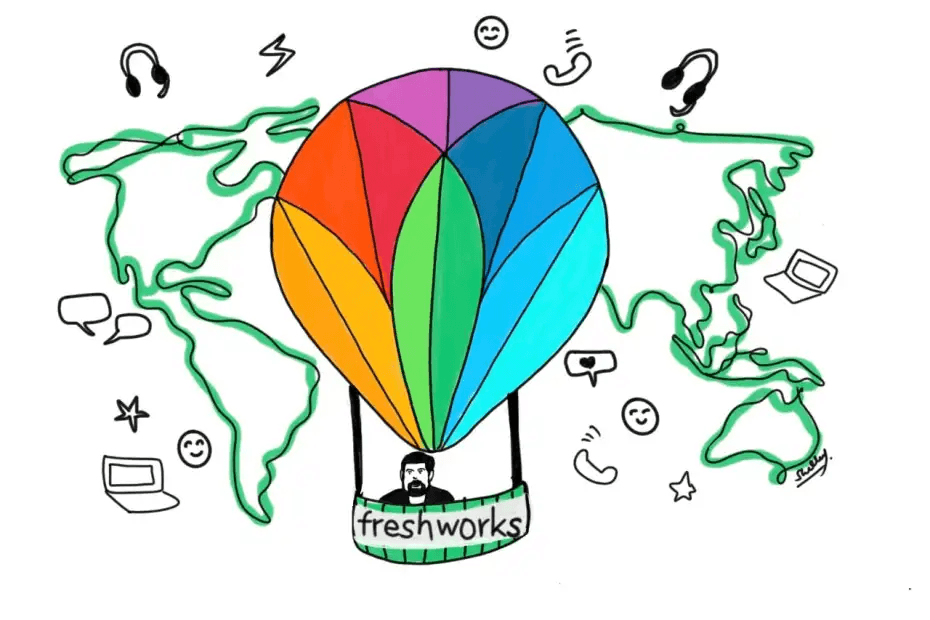
Oct 17, 2021
Can Freshworks Freshen India SaaS Globally?
Profile
Productivity
SaaS
IPO
B2B
Services
Last fortnight, India added 500 more “Tech Crorepatis” as Freshdesk Inc IPOed at a valuation of $13 billion, making it the first Indian SaaS company to get listed on Nasdaq.
God Commands, I Build
Girish Mathrubootham was born in March 1974 in a middle-class family.
He did not have the best childhood as his parents separated when he was just 7. This led to an emotional scar on Girish but also led to maturity which was very rare to find at a young age.
He completed his BE from SAASTRA University in 1996 and followed it with an MBA from the University of Chennai specialising in marketing.
Being an average student, Girish developed his own way of learning things, which was different from what one normally does in a classroom. He had this habit of structuring all engineering subjects like logical stories to easily remember.
With his love for simplifying complex concepts, Girish started teaching Java to a few of his friends alongside his job at HCL as a trainer. He was doing it more like a hobby but soon 40-50 people started attending every month.
Soon he got bored and moved to the US where he stayed for a year. But his entrepreneurial itch made him come back to India and set up a training company in 2001.
His second attempt did not go really well. The dot-com bust and cyclicity of a business taught him some important lessons on how to navigate in a tough market.
Things changed from 1999 to 2001. Earlier, there was a pull for Java training and by 2001 it became a push product.
He understood that going against the tide may not be a good idea and went back to a full-time job with AdventNet, Zoho. He grew in the company and by 2010, served as Director and VP of Product Management.
In fact, it was Sridhar Vembu, Founder & CEO of Zoho, who could see how Girish had great empathy for customers and could be a great product manager.
That’s how after spending a few years in the training/pre-sales department, Girish landed into product management, something that would change his and many lives in future.
By 2010, things were going well for Girish. He was 36, had two school going kids and he had just fulfilled every Indian’s dream of owning a house by taking an INR 50 lakh home loan. Everything was ideal to continue with a well-paying job and not so ideal to take the risky path of entrepreneurship.
But something big was about to happen. As with all big things, it would start with something small.
What would light the fire would be a comment on Hacker News.
I’ll Do What I Say For Customers
Zendesk, a US-based company, has recently raised its prices by up to 300%.
Ironically, customers were unhappy with the non-customer centricity of a company providing customer care solutions.
Girish knew there was a problem and it needed to be solved. By then he had already built 4 helpdesk related products. He knew he had the right understanding to build a solution here.
He decided to build a fresh Helpdesk solution, which would be called Freshdesk.
He went and discussed this with his colleague Shan Krishnasamy, who did not take even 5 minutes to jump on the idea he and Girish were going to build together.
In October 2010, Freshdesk was born in a small 700 square feet warehouse in Chennai.
How to Make a Fresh Start
It took them around eight months to build the first product. What Freshdesk was doing differently was to convert all customer interactions such as phone calls, emails, social media queries into a ticket. These could then be acted upon and resolved by customer care teams easily.
To build this, Girish needed some initial capital to build a product that can be sold to prospective clients and he did not leave any stone unturned to get those funds. This included participating in relevant contests that could help bag some attractive prize money.
There was a blogging contest that Appsumo was running on lean startups. Girish gave it a shot and showcased how Freshdesk started from a comment on Hacker News.
It was a great story. It did not win the contest but did something much more useful for Girish. He got 300 signups for a product that was not even ready. Talk about hitting PMF before having a product in place
The early traction was a sign of what Freshdesk could be. The icing on the cake was that Girish could impress a set of very renowned investors from the US
They introduced him to Indian investors who were just starting to put money in the Indian startup ecosystem.
Soon, their first customer signed up from Australia and six more customers from four different continents signed up making it a global company from day 1.
This validation from initial customers and introductions to investors was encouraging for the Freshdesk team.
But what was Freshdesk actually offering back then in 2010?
Customer Justice is the Freshworks Way
Freshdesk helped its clients to plug and play a customer care software that made their customer care teams more effective.
It helped in saving their time and improving the client's reputation as a customer-centric brand which results in business growth.
That was the long term solution that Girish envisioned to build
Freshdesk would be a simple user-friendly & cost-effective CRM that can be used by a long tail of global SMBs and not just the top-tier enterprise customers.
The SMB would be the hero customer for Freshworks.
What really helped Freshdesk hit PMF so early was their understanding of customer key pain points that they could gather by talking to their early prospects.
Girish himself mentions in this blog from 2011, customers back then were looking for a solution to their core problems and not fancy features like FB wall-based reply option. SMBs were not looking for multiple invoices and wanted to deal with a single CRM solution.
There were different customer segments like companies with multi-brand support requirements, which were not being focussed on by many competitors.
This helped the team to prioritize the right features like business hours were made first while Twitter integration could wait.
The other differentiation that Freshdesk could build, more at a company level translating into a product strategy, was the salary difference. The cost of talent based in India as compared to the companies operating out of the United States was huge, almost 1/8th of US.
Due to this, Freshdesk could even serve a customer which was 1/8th the size and still remain profitable. That was the secret sauce.
Zendesk was going after the elephants while Freshdesk could focus on deer & rabbits.
Strategies are great, but limited capital was the reality. Girish continued to work on the product, getting customers and participating in contests. At the time, it was very hard to convince customers that Indians could build a good enough SaaS product.
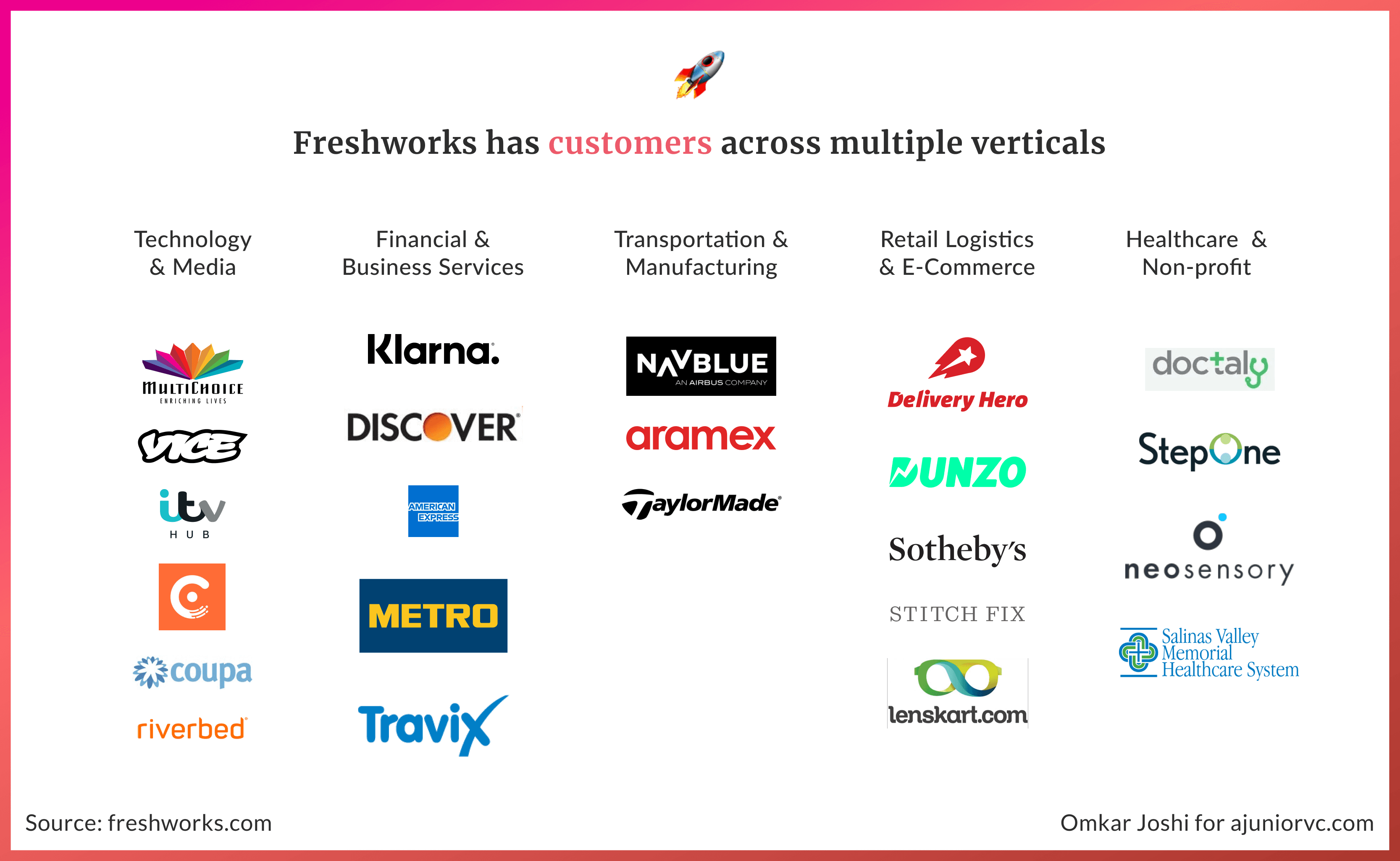
It was a mindset that saw India as a back office, not an innovator of top quality products.
In 2011, Girish went on to participate in the Microsoft BizSpark contest and won the first prize of $40,000. This was the money he had not accounted for and used most of it on marketing efforts.
While it wasn’t the most effective marketing campaign and today’s digital marketers may frown upon the RoAS (Return on Ad Sales) it delivered, still it helped Freshdesk reach a customer base of 70.
By now, Freshdesk had generated enough interest for investors and they were ready to raise their first seed investment in late 2011.
Be a Good Full Stack Company
After raising for Freshdesk, Girish was keen to pursue the dream of building a product company.
This included launching and scaling multiple products. In fact, Girish and his co-founder, Shan were so serious about this strategy that they had bought 40 domain names that started with the word ‘fresh’!
Girish has a passion for great products and has often spoken of how he hopes for India to become a product nation. It was no surprise then that he had this impatience to launch multiple products.
By 2012, they were executing relentlessly on Freshdesk and scaled to 1,000 customers. At the same time, Girish and his cofounder started working on a new product in stealth as they pursued their dream of a multi-product company.
Around that time, Girish happened to be introduced to a popular Silicon Valley investor.
Girish pitched his multi-product strategy expecting to receive immediate validation. But to Girish’s surprise the investor discouraged him and gave him, what Girish regarded, some of the best advice he had ever received.
The most important piece of advice being – “Don’t change the narrative of your company”.
Girish and team went back and focused on scaling their current product. Towards early 2013, they had a new idea. They created an IT Service Desk called Freshservice.
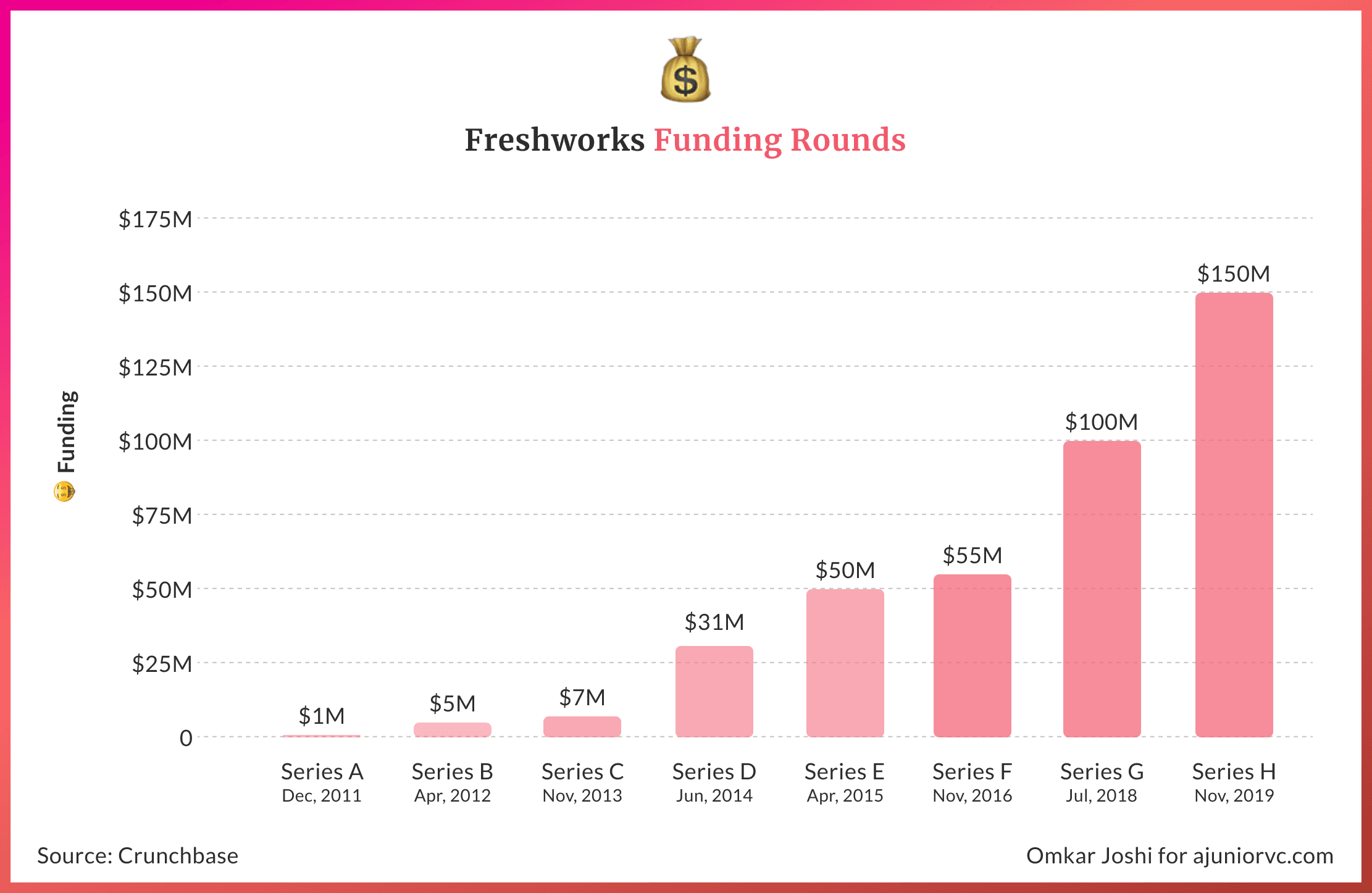
Hockey stick growth
The key was that they could stay in control of their narrative without doing anything too different from their original product. They remained a company that built helpdesk software, with Freshdesk aimed at customer support teams and Freshservice meant for internal IT support teams.
It was a natural extension as they noticed a lot of teams were using Freshdesk for internal support. They finally launched Freshservice in Jan 2014.
Within 10 months of its launch, Freshservice scaled to $1M in revenue. They achieved this milestone much faster than Freshdesk while bringing in 3x the ARPU.
Freshdesk was a great example of the magic that can happen when you get the timing of diversification spot on. The success of Freshservice helped them demonstrate to their investors that they could successfully simultaneously build multiple products.
This was a key turning point in their journey that helped them align their board with their strategy. It also gave the team the confidence to take on more challenges.
By 2015, the company raised a $50M Series E. The company was going after a giant market
Tell the World a Hundred Times about Fresh
The strategy Freshdesk followed was effective, but not unique.
Countless startups first targeted small companies as their way to enter a large market. Walmart was built only in Tier 2 US towns before it became large enough for New York. Clayton Christensen’s Disruptive Innovation describes this path.
As expected, Freshdesk soon started to attract enterprises on the back of success with SMBs.
As the quality of the products improved on the back of hiring better and more experienced designers, engineers, and product managers, Freshdesk was able to attract companies that require sophisticated solutions.
A result of all this was that Freshdesk was playing in a large market.
The TAM for them is approximately $120Bn. This could be broken down into two parts the first being the Customer relationship Management (CRM) opportunity which was estimated to be $76Bn and the second being the System and Service Management (SSM) opportunity which was estimated to be $44Bn in size.
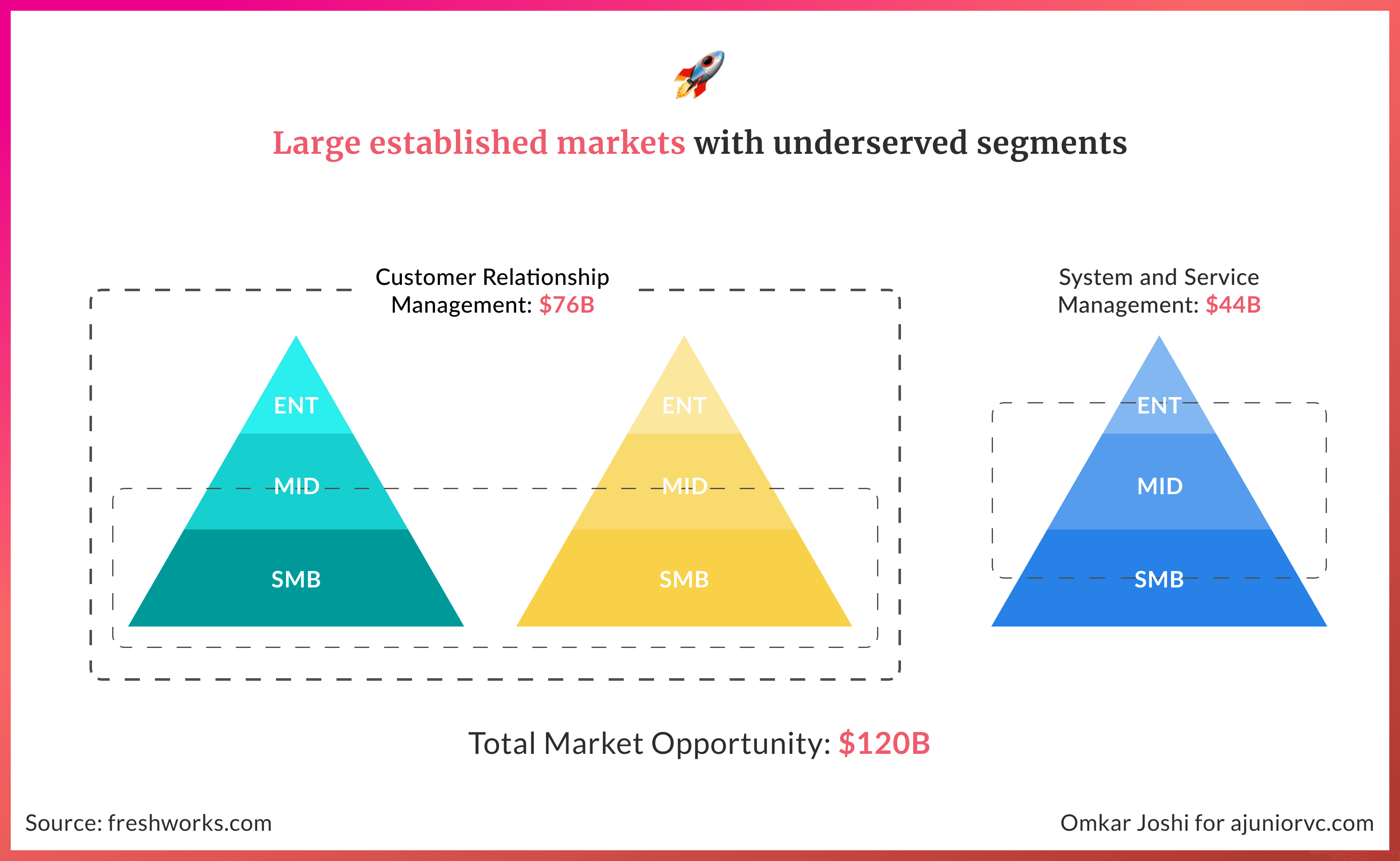
Huge Markets need Huge Visions
The large market, as well as global focus, would help it raise its next rounds
Whichever way you choose to look at the market, it was huge and Freshdesk had barely scratched the surface. The best part was that these are not winners take all markets either.
Unlike the consumer world where network effects create monopolies, these phenomena are not prevalent in most B2B SaaS offerings as networks are confined to single organisations.
The Fresh flywheel was spinning.
The next product the team launched was Freshsales, A CRM solution based on their own experience and that of their customers’ of having to integrate the helpdesk solution with an external CRM.
The integration was tedious and expensive as it required multiple other products to smoothen the integration. In 2016 Freshsales went live. The launch was followed by glowing reviews from customers.

The solution saw good adoption from new and existing customers. What started as Freshdesk was now Freshservice and Freshsales.
I may come Late, but I will be the Latest
By 2017, the company would pull it all together, keep it Fresh and call it Freshworks.
With the Freshworks rebranding, the company also expanded its vision to helping businesses win customers for life.
They did this by leveraging their unique philosophy of Indian democratic design that helps them build software that is simple, scalable, affordable, and epitomizes true craftsmanship, all while allowing companies to be self-reliant.
Along with the expansion of vision the type of customers Freshworks was selling to also changed from SMBs to mid-market enterprises. Unlike in SMBs in larger enterprises, the decision-maker for the purchase of a tool is different from the user.
All of this has meant the way the company thought about sales evolved. From selling individual products to selling solutions that help businesses deliver great customer engagement.
Building new products is one thing but to fully deliver on the potential of these products several supporting functions needed to be put in place. Freshworks’s culture ensured that they stayed a step ahead of the curve.
By 2018, the company had raised a Series G round of $100M but the competition was also heating up
As Freshworks operated across multiple product segments, it meant that it faced competition from a diverse set of players across these segments.
In customer experience software, it competed with Salesforce. and Zendesk as well as Oracle and SAP. IT service management competitors include ServiceNow and Atlassian. In customer relationship management, or CRM, software, it not only competes with Salesforce but also with Microsoft Corp.’s Dynamics service.
Despite the pressure, Girish had been operating the company by taking an employee-driven, customer-centric, product-led approach that helped him connect with his clients and employees.
When Girish left Zoho to start Freshworks, he not only got an array of skills with him, but his Zoho Mafia along.
They had been working with him for at least five years, and he knew the strengths of his early team.The timing of Freshworks was another factor for their success. By having a support system for 52k companies across 120 countries around the world, all started in Chennai - a city filled with empathy, full of hospitality, and great command of the language.
The approach to build support teams from Chennai was a blockbuster. With low operational costs compared to overseas counterparts and user-centric products, Freshworks may have started slow.
It took 18 months to hit the first $1MM and five years to break through $100MM with just a couple of products and a few acquisitions.
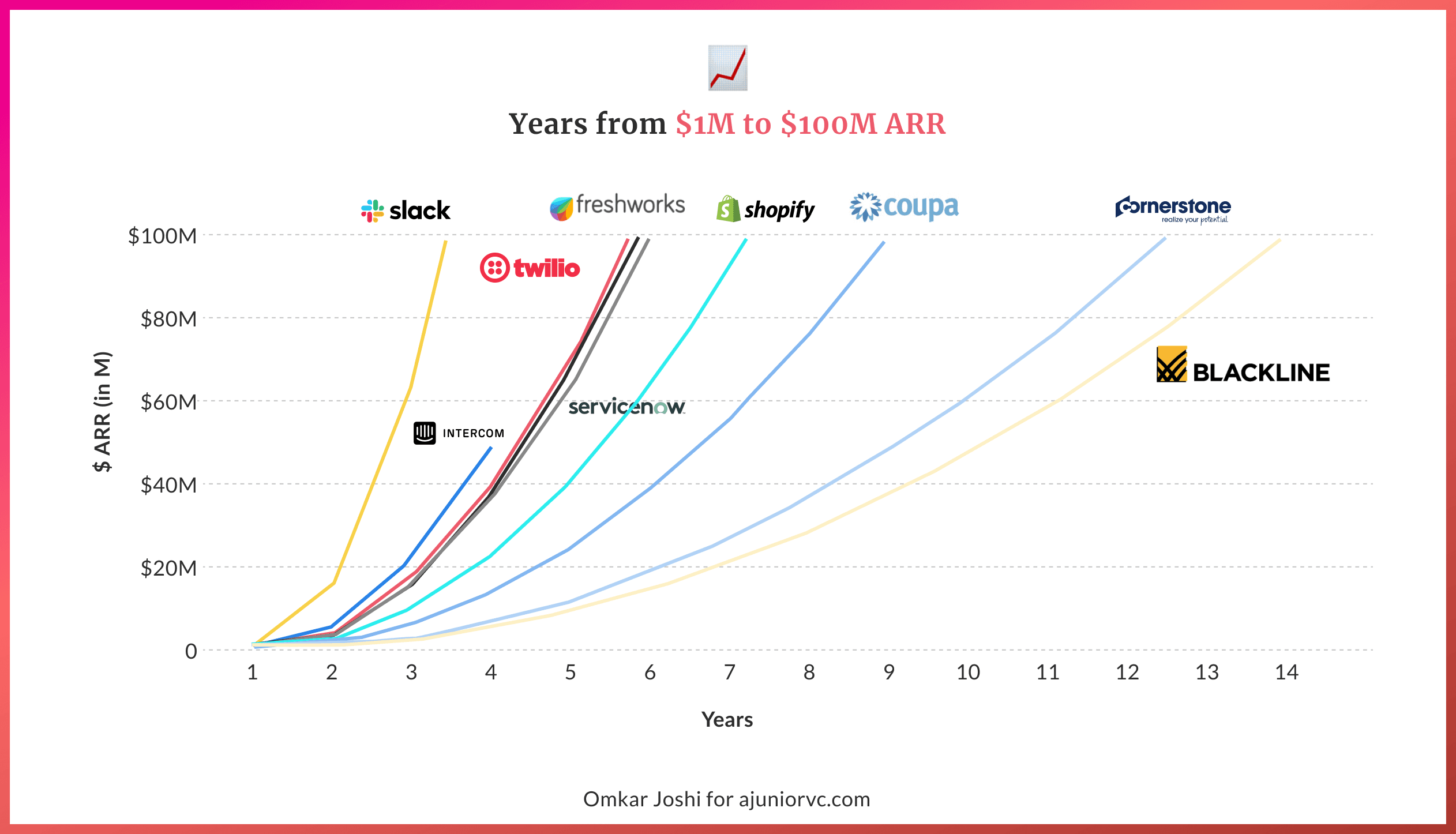
The full-blown vision was taking shape slowly and steadily. Freshworks embodied Superstar Rajnikanth in the Film Baba, “Naan late aa vandhalum latest aa varuvein “I may come late, but will be the latest”.
Freshworks was now beginning to fly
My Way is My Own
By 2019, the idea of building from Chennai to the world.
But having a majority of the customers from the US, Freshworks had to make a move. Initially adamant about moving away from India, Freshworks set up another office in the United States, closer to their customers.
That was an instant hit, and now they could garner more clients.
The next 100MM would soon take only a year and a half to hit the milestone, by early 2020. Freshworks was now raking nearly $200MM ARR and was one of the few SaaS companies from India to do so, and at a record pace.
When things were going fine, Freshdesk would soon be hit by a lawsuit in March 2020 from the same work school Girish had graduated from. Zoho accused Freshworks of stealing customer data that accounted for misappropriation of trade secrets.
That would turn out to be bad press for the company that was now on foreign grounds and making a name for itself. News spread that Freshdesk also used Zoho's confidential revenue and pricing figures.
At the same time, the world was stuck by COVID-19 and businesses around the globe were forced to go digital-first.

Pressured from all sides, Freshdesk responded like a champion by taking long strides and by doubling its omnichannel support revenues. Through the year, Freshdesk would help the world go digital when all of us were forced to work from home.
Freshworks, like many businesses in India, would do its bit in providing digital assistance to people to get treated amidst the pandemic.
Freshworks' survey indicated that businesses include three pillars - Customer first, Employee first, and Community first.
Their empathy for society was a testament to Freshworks' success in helping them garner customer love. It was now gearing up for an IPO.
When only a few Indian companies had listed in the US, it would be tricky, as the ones listed were not doing so well.
But again, Freshworks decided to take the path that was not taken so often and was preparing to list in the United States.
It was also in excellent shape to take that path.
Catch Me if You Can
Freshworks was growing rapidly despite its impressive scale.
At the time of filing its prospectus in June 2021, the company reported revenues of $308MM for the period from July 2020 to June 2021.
This was a growth of 49% over the previous 12-month period. Gross margins held relatively stable through these periods coming in close to 80%.
While growth has been accelerating, losses have been contracting.
The company reported revenue of $168.9 million for the first six months of 2021 for a loss of $9.8 million, compared with $110.5 million and a loss of $57.1 million for the same period in 2020.
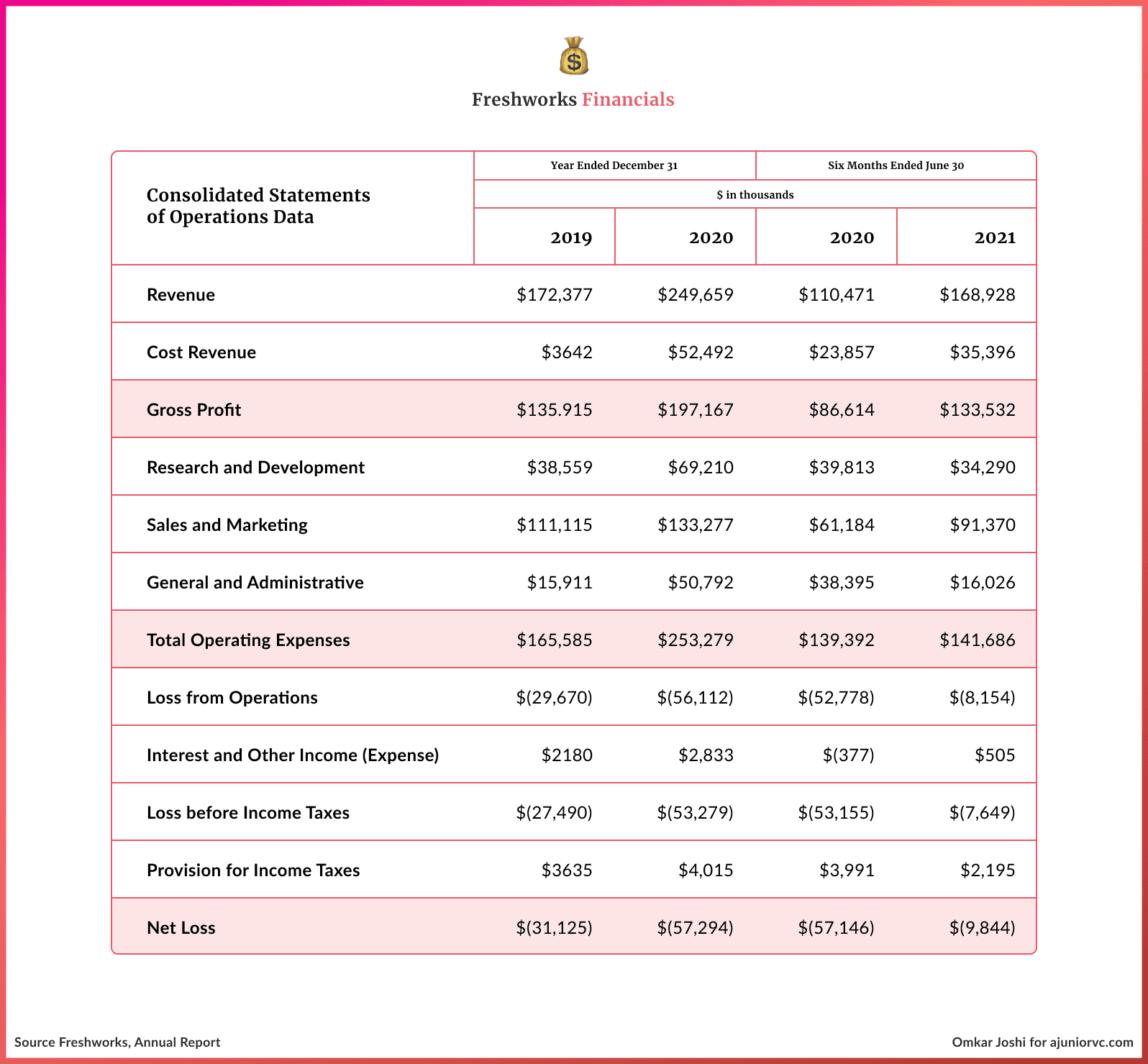
A business getting stronger
Freshworks had multiple growth levers that they could pull to accelerate revenue growth.
These included adding new customers, launching new products and growing revenue from existing customers. The company has been focusing on extracting more revenue from existing customers.
They call this strategy ‘Land and Expand’, based on the numbers this strategy seems to be working. The company has grown the number of customers contributing more than $5K on an annualized basis from 8,588 in December 2019 to 13,326 in June 2021.
These customers now contributed 84% of total revenue. What was even more impressive is that the number of customers contributing more than $50K in revenue on an annualized basis has grown from 534 in December 2019 to 1,164 in June 2021.
Even when you look at net dollar retention, a metric that SaaS investors track closely, the company was been doing well. Net dollar retention simply demonstrates the company’s ability to sell more of its product to its customers over time.
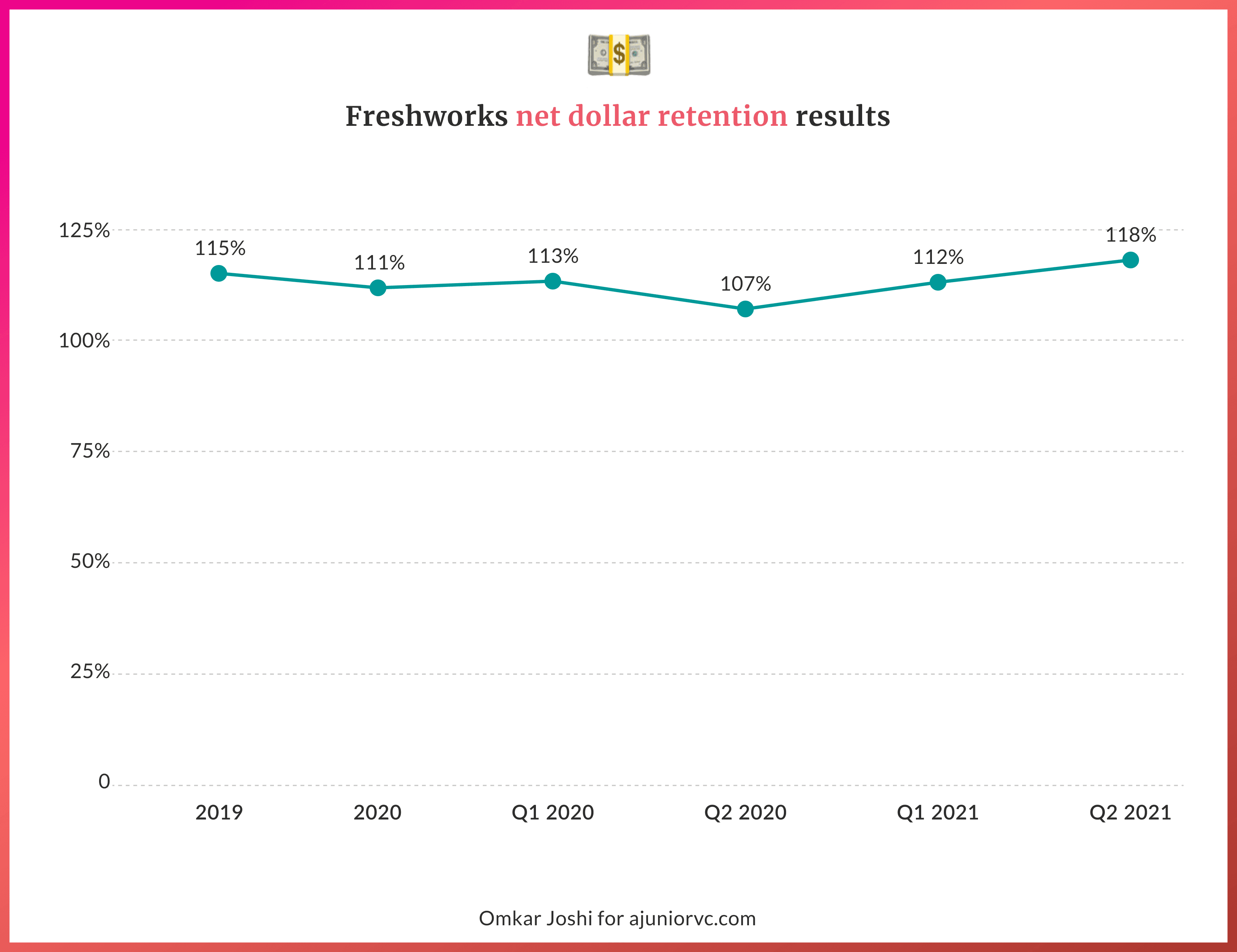
As per the company’s prospectus, the 53% revenue growth rate in the first half of 2021 was skewed towards growth in revenue from existing customers. 62% of the 53% growth came from existing customers while new customers contributed to the remaining 38%.
To put Freshworks growth in context, per the Bessemer Cloud Index, Freshworks is growing a little bit faster than the top quartile of public SaaS companies.
A dream started 10 years ago was now finally bearing fruit.
A Lion Comes in a Tribe to IPO
On 22nd September 2021, Project Superstar would hit IPO.
It would go on to make the whole Indian tech community proud as the first Indian SaaS start-up would raise their flags high at Times Square, Nasdaq.
That day, they had won. It would create 500+ crorepatis in India, and nearly 76% of Freshworks employees held the stock
70 of them were under the age of 30; all would rejoice the moment with each other. The stock surged over 21% on day one, which was a bumper listing.
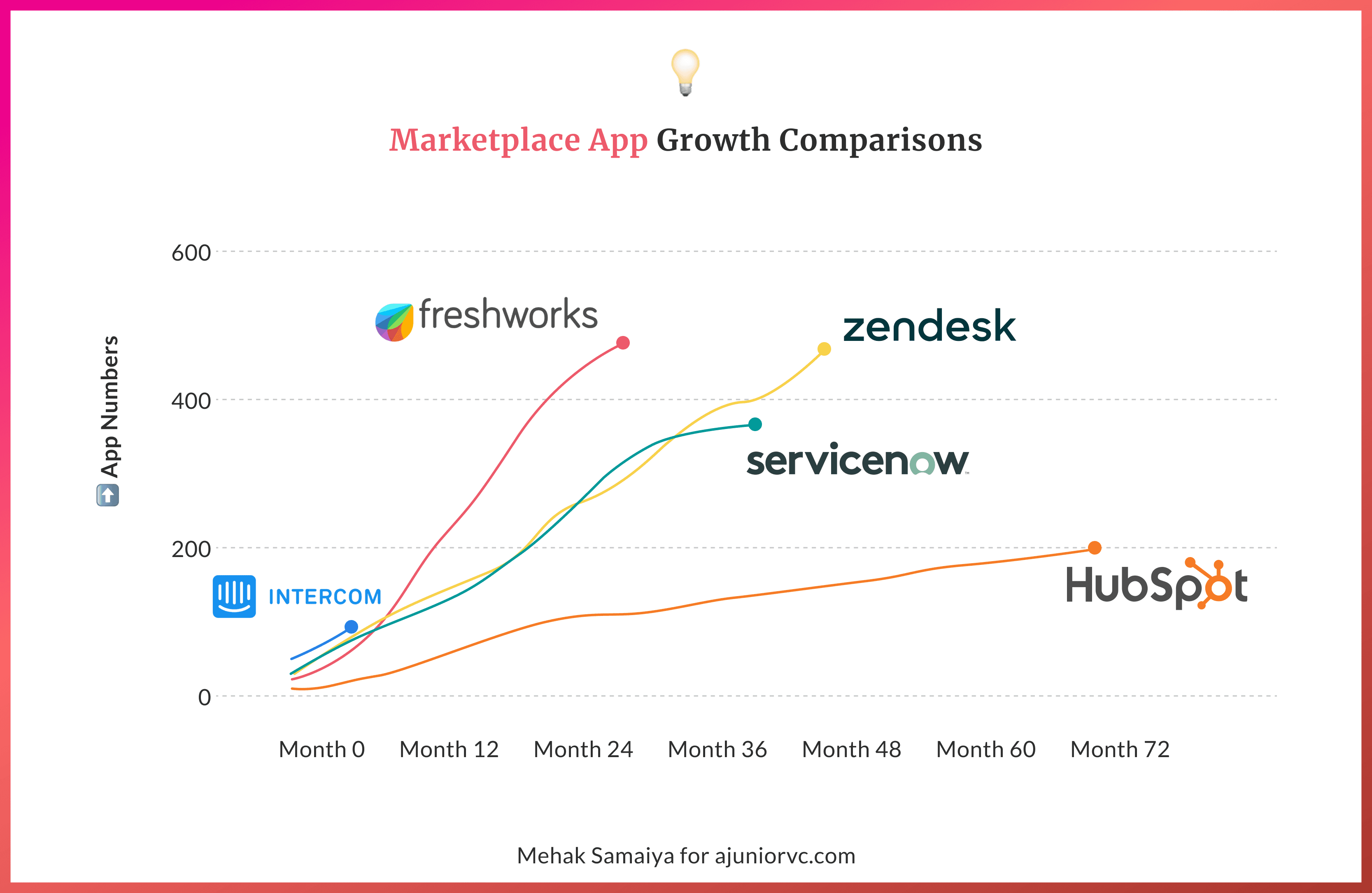
With serving an array of products. By now, it was evident that what Superstar Rajnikant was to Indian Cinemas, Freshworks was to the start-up ecosystem.
Both were internationally acclaimed, offer variety, and are the epitome of simplicity.
By serving in over 120 countries, it learned the essential characteristics of various companies and the products they were requiring.
Freshworks realised that the previous decade belonged to the products that serve customer engagement, but the next decade belongs to employee engagement.
The ability to make the employees' processes and lives more accessible is a function of higher sales, rewards, and retention.
Much of the future products from a SaaS-driven company such as Freshworks would see products to ease employees working styles, reward their work, and integrate cross-products driven through APIs.
The proliferation of digitization, and the ability to fit arrays of products in place, has given an upper edge to Freshworks due to the network effects of over 52k companies using it across the globe for a relatively lesser cost than its foreign counterparts.
The ambitions are wilder and bigger now. It now aims to become the first India SaaS company to reach an ARR of $1B in the next five years.
Freshworks in true Rajnikanth style has announced, Singa nadai pottu Sigaraththil yeru, Sigaraththai adainthaal Vaanaththai yeru.
Walk like a lion and climb the peak. Reach the peak and climb into the sky.
As the founder mentioned in its S-1 filing, Freshworks was a player which was not supposed to win.
But with steely determination, Freshworks has inspired not just the SaaS ecosystem, but the whole start-up space worldwide, where ordinary men can achieve extraordinary things aka Thalaiva style.
What started with a comment, lit a fire. There were naysayers who believed Indians couldn’t build global products. Here we were with a company that had freshened up that entire mindset.
As the world became more digital and connected, it became easier for Indians to build for the world. No longer did Indians need to go to the US to sell in person. Their product could be sold on the internet, on its own merit rather than on the merit of where it was built from.
Freshworks refreshed how Indian SaaS was looked at. As a bevy of SaaS founders now follow Freshworks, the next decade is going to be more exciting for Indian builders.
Freshworks has freshened Indian SaaS globally and will lead the way for the next generation.
Authors: Abhinay, Shreyans, Varun, Keshav, Aviral Design: Shelley, Omkar